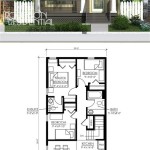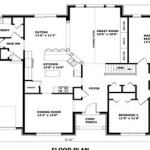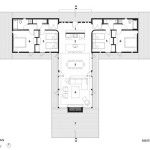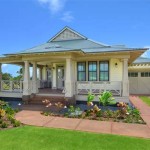Walkout house plans refer to architectural designs for homes that feature a lower level that opens directly to the outdoors, typically at ground level. This design allows for a seamless connection between the living space and the surrounding landscape.
Walkout house plans are commonly used in areas with sloping terrain, where the lower level can be built into the hillside and provide access to a backyard or patio. They are popular in both rural and suburban settings, as they offer the benefits of indoor-outdoor living while maximizing the use of space and natural light.
In this article, we will delve deeper into the advantages and disadvantages of walkout house plans, explore their design variations, and provide tips for choosing the right plan for your needs.
When considering walkout house plans, it’s important to keep in mind the following key points:
- Maximize natural light
- Connect indoor and outdoor spaces
- Enhance accessibility
- Increase energy efficiency
- Utilize sloping terrain
- Create additional living space
- Consider drainage and moisture control
- Plan for adequate access to the outdoors
- Factor in potential construction costs
By carefully considering these factors, you can design a walkout house that meets your specific needs and preferences.
Maximize natural light
Walkout house plans offer a unique opportunity to maximize natural light in the lower level. By strategically placing windows and doors along the walkout wall, you can flood the space with sunlight, creating a bright and inviting atmosphere. This natural light can reduce the need for artificial lighting, resulting in energy savings.
- Large windows and sliding glass doors: Installing large windows and sliding glass doors along the walkout wall allows for ample natural light to enter the lower level. These openings provide panoramic views of the outdoors and create a seamless connection between the indoor and outdoor spaces.
- Clerestory windows: Clerestory windows are placed high on the wall, near the ceiling, to allow natural light to penetrate deep into the lower level. They are particularly effective in rooms that have limited wall space for windows.
- Light tubes: Light tubes, also known as solar tubes or sun tunnels, are devices that capture sunlight from the roof and redirect it into the lower level through a reflective tube. They are a great option for providing natural light to rooms that do not have direct access to the outdoors.
- Skylights: Skylights are installed on the roof to allow natural light to enter from above. They are a versatile option that can be placed in various locations to maximize light distribution.
By incorporating these strategies, you can create a walkout house that is filled with natural light, reducing the need for artificial lighting and creating a more comfortable and inviting living space.
Connect indoor and outdoor spaces
Walkout house plans excel at connecting indoor and outdoor spaces, creating a seamless transition between the living areas and the natural surroundings. This connection offers several benefits, including increased natural light, improved ventilation, and a stronger connection to nature.
Expansive outdoor living areas: Walkout house plans often feature expansive outdoor living areas, such as patios, decks, or balconies, that are directly accessible from the lower level. These outdoor spaces extend the living area and provide a place to relax, entertain guests, or enjoy the outdoors.
Large windows and sliding glass doors: Large windows and sliding glass doors along the walkout wall create a visual connection between the indoor and outdoor spaces. These openings allow for natural light to flood the lower level and provide panoramic views of the surroundings.
Indoor-outdoor flow: The seamless flow between the indoor and outdoor spaces is a defining characteristic of walkout house plans. By removing barriers and creating open sightlines, these designs encourage occupants to spend more time outdoors and bring the beauty of nature into their homes.
By connecting indoor and outdoor spaces, walkout house plans enhance the overall living experience, promote a healthier lifestyle, and create a stronger connection to the natural environment.
Enhance accessibility
Walkout house plans offer several advantages in terms of accessibility, making them suitable for individuals of all ages and abilities.
Single-level living: Walkout house plans often incorporate single-level living on the lower level, which eliminates the need for stairs and provides easy access to all essential living areas. This is particularly beneficial for senior citizens, individuals with disabilities, or families with young children who may have difficulty navigating multiple levels.
Wider doorways and hallways: Walkout house plans can be designed with wider doorways and hallways to accommodate wheelchairs and mobility devices. This ensures that all areas of the home are easily accessible and maneuverable, promoting independence and safety.
Accessible outdoor spaces: The direct access to outdoor spaces from the lower level makes it easy for individuals to enjoy the outdoors without having to navigate stairs or other barriers. This is especially important for those who use wheelchairs or have limited mobility.
By enhancing accessibility, walkout house plans create a more inclusive and comfortable living environment for people of all abilities.
Increase energy efficiency
Walkout house plans offer several opportunities to increase energy efficiency, resulting in lower utility bills and a reduced environmental impact.
Maximize natural light
By incorporating large windows and sliding glass doors along the walkout wall, walkout house plans allow for ample natural light to enter the lower level. This reduces the need for artificial lighting, leading to energy savings. Additionally, natural light can help regulate indoor temperatures, reducing the demand for heating and cooling systems.
Thermal mass
The concrete foundation and earth-sheltered walls of a walkout house act as a thermal mass, absorbing and storing heat during the day and releasing it at night. This helps to regulate indoor temperatures, reducing the need for heating and cooling systems and saving energy.
Passive solar design
Walkout house plans can be designed to take advantage of passive solar design principles. By positioning the house to maximize exposure to sunlight, and incorporating large south-facing windows, the lower level can be naturally heated during the winter months, further reducing energy consumption.
Energy-efficient appliances and systems
In addition to the inherent energy-saving features of the design, walkout house plans can also incorporate energy-efficient appliances, lighting, and systems. This includes ENERGY STAR-rated appliances, LED lighting, and high-efficiency heating and cooling systems, which can significantly reduce energy consumption.
By implementing these energy-saving strategies, walkout house plans can create comfortable and sustainable living spaces while minimizing energy consumption and reducing environmental impact.
Utilize sloping terrain
Walkout house plans are ideally suited for sloping terrain, offering several unique advantages:
- Maximize views: By building into the hillside, walkout house plans can take advantage of elevated views of the surrounding landscape. The lower level can be designed with large windows and decks to capture panoramic vistas, creating a strong connection to the outdoors.
- Create usable outdoor space: Sloping terrain can create unusable or difficult-to-access outdoor space. Walkout house plans can transform this sloped area into a usable backyard, patio, or garden, providing additional living space and recreational opportunities.
- Reduce excavation costs: Building into a hillside reduces the need for extensive excavation, which can significantly lower construction costs. The natural slope of the land provides support for the lower level, eliminating the need for costly retaining walls or deep foundations.
- Energy efficiency: The earth-sheltered design of a walkout house helps to regulate indoor temperatures, reducing the need for heating and cooling systems. The hillside provides insulation, reducing energy consumption and lowering utility bills.
By utilizing sloping terrain, walkout house plans offer a unique opportunity to create homes that are both visually appealing and energy-efficient, while maximizing outdoor living space and reducing construction costs.
Create additional living space
Walkout house plans offer a unique opportunity to create additional living space by utilizing the lower level, which opens directly to the outdoors. This additional space can be used for a variety of purposes, such as:
- Guest suite: The lower level can be designed to include a guest suite, complete with a bedroom, bathroom, and living area. This provides a private and comfortable space for guests to stay, while maintaining their privacy from the main living areas of the home.
- Home office: The lower level can be converted into a dedicated home office, providing a quiet and distraction-free workspace. With access to natural light and outdoor views, the home office can be a productive and inspiring environment.
- Home gym: For fitness enthusiasts, the lower level can be transformed into a home gym. With ample space for exercise equipment and direct access to the outdoors for fresh air and ventilation, the home gym can be a convenient and motivating space to work out.
- Entertainment room: The lower level can be designed as an entertainment room, complete with a home theater system, comfortable seating, and a bar area. This dedicated space provides a perfect setting for movie nights, sporting events, and entertaining guests.
By incorporating a walkout basement into the design, homeowners can significantly increase their living space and create a variety of functional and enjoyable areas that meet their specific needs and lifestyle.
Consider drainage and moisture control
When designing walkout house plans, it’s crucial to consider drainage and moisture control to prevent water damage and ensure the structural integrity of the home. Here are key points to keep in mind:
- Grading and drainage system: The land around the walkout basement should be graded to slope away from the house, directing water runoff away from the foundation. Install a drainage system, such as French drains or gutters, to collect and redirect excess water, preventing it from seeping into the basement.
- Waterproofing: The exterior walls of the walkout basement should be waterproofed to prevent water penetration. This can be achieved through the application of a waterproofing membrane or sealant to the foundation walls and any areas where the walls meet the ground.
- Vapor barrier: A vapor barrier should be installed on the interior side of the basement walls to prevent moisture from entering the living space. This barrier can be made of polyethylene sheeting or other moisture-resistant materials.
- Proper ventilation: Adequate ventilation is essential to prevent moisture buildup in the basement. Install vents or fans to circulate air and remove excess moisture, especially in areas where humidity levels may be high.
By implementing these drainage and moisture control measures, homeowners can protect their walkout basements from water damage and ensure a dry and healthy living environment.
Plan for adequate access to the outdoors
When designing walkout house plans, careful consideration must be given to ensuring adequate access to the outdoors. This involves creating seamless transitions between the indoor and outdoor living spaces, providing multiple access points, and maximizing the functionality of outdoor areas.
Multiple access points: Walkout house plans should incorporate multiple access points to the outdoors to provide convenience and accessibility. The primary access point is typically through sliding glass doors or a walkout door from the main living area. Additional access points can be added through the lower level bedrooms, family room, or other areas to provide easy access to the backyard, patio, or deck.
Seamless transitions: The transition from the indoor to outdoor living spaces should be seamless and inviting. This can be achieved by using large windows and doors that create a visual connection between the two areas. Decks and patios should be designed to flow naturally from the interior spaces, creating an extension of the living area outdoors.
Functional outdoor spaces: The outdoor spaces accessible from the walkout basement should be designed to maximize functionality and enjoyment. This may include creating a covered patio for shade and shelter, installing an outdoor kitchen or grilling area for entertaining, or designing a fire pit area for relaxation and warmth.
By carefully planning for adequate access to the outdoors, walkout house plans can create a strong connection between the indoor and outdoor living spaces, enhancing the overall functionality and enjoyment of the home.
Factor in potential construction costs
Walkout house plans typically require more complex construction methods compared to standard single-story homes due to the excavation and foundation work involved. Here are key factors that influence the construction costs of walkout house plans:
- Excavation and site preparation: Building a walkout basement requires significant excavation to create the lower level and ensure proper drainage. The cost of excavation can vary depending on the slope of the land, soil conditions, and the need for retaining walls.
- Foundation: Walkout basements require specialized foundation systems to support the structure and prevent water damage. The type of foundation used, such as poured concrete or block walls, will impact the overall cost.
- Materials: Walkout basements often require additional materials, such as waterproofing membranes, drainage systems, and specialized insulation, to ensure structural integrity and prevent moisture issues.
- Labor: The construction of walkout basements involves specialized skills and labor, which can increase the overall labor costs compared to standard home construction.
In addition to these factors, the size, complexity, and design features of the walkout basement will also influence the construction costs. It’s important to carefully consider these factors during the planning and budgeting process.
Cost-saving measures: While walkout basements generally require higher construction costs, there are ways to minimize expenses. These include choosing a simpler design, optimizing the excavation process, and selecting cost-effective materials and finishes.
Long-term benefits: While the upfront construction costs of walkout basements may be higher, they offer several long-term benefits. The additional living space can increase the value of the home, and the energy-efficient features can lead to lower utility bills over time.
By carefully considering the potential construction costs and long-term benefits, homeowners can make informed decisions when choosing walkout house plans that meet their needs and budget.










Related Posts








